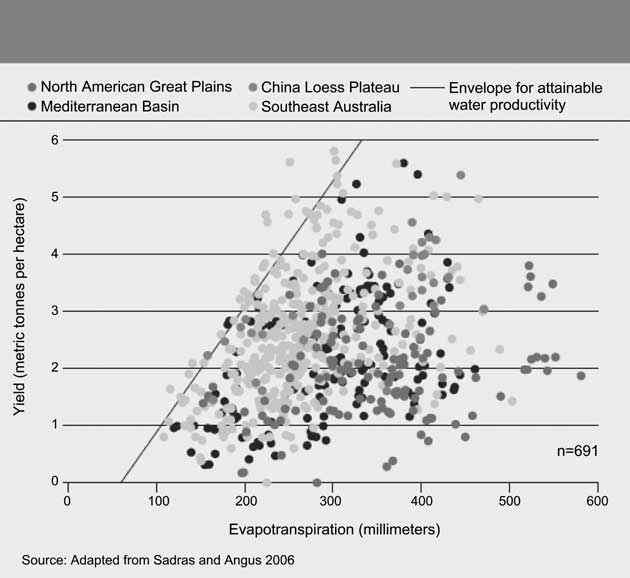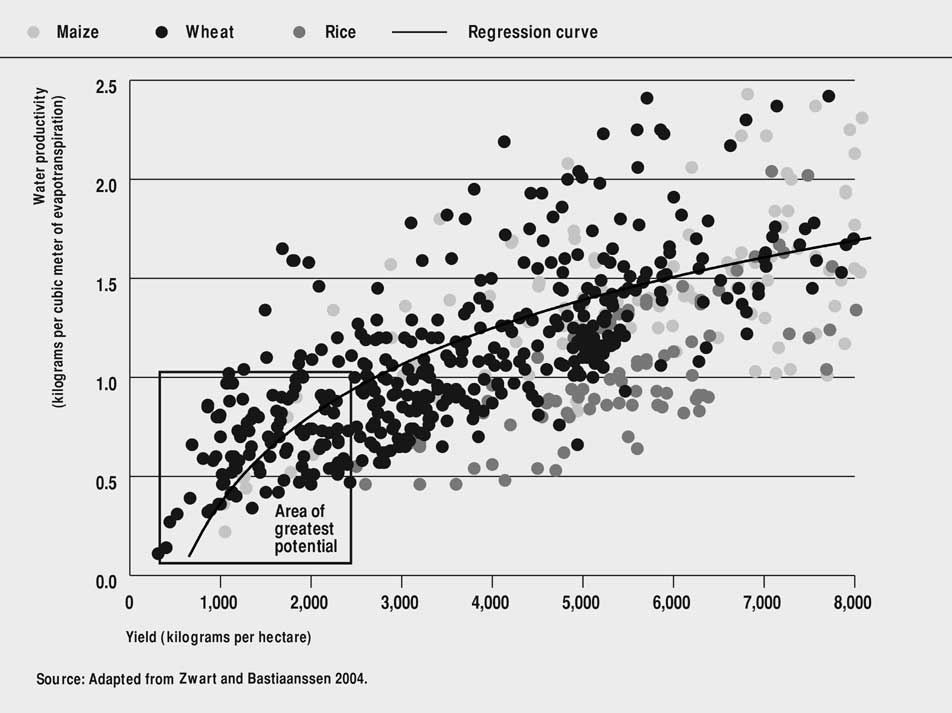more withdrawals of water for agriculture, surely a threat to aquatic ecosystems and capture fisheries in many areas.
The factors that contribute to optimistic and pessimistic estimates of total water needs are primarily differences in water productivity. Without gains in water productivity, water resources devoted to agricultural production will likely increase by 70-90%. On top of this is the amount of water needed to produce fiber and biomass for energy. The real world is more complex than the scenarios. Improvements will need to be made in water management across all agricultural systems, rainfed, irrigated, and combinations in between. It will be necessary to look beyond increasing water productivity to target poor people and ecosystems to benefit from these improvements. AKST will be needed that targets both physical (not enough water to meet all demands) and economic (not enough investment in water) water scarcity. Climate change and bioenergy increase the scale of the challenge, by increasing pressures on resources, and by increasing climate variability, but do not alter the nature of the challenge.
6.6.3.1 Managing evapotranspiration
Optimistic scenarios for mitigating increased water demand in agricultural systems require that water productivity be increased. This can be achieved with existing AKST, e.g., at the plot level in rainfed systems where evaporation can be very high and soil constraints are still significant, and at a system and basin level by reducing unproductive losses in landscapes. Crop breeding to gain increased benefit from water used and as yet unexplored opportunities to use precision water management to raise biomass/transpiration ratios are promising for intensive systems.
There is significant scope to reduce evapotranspiration (ET) per unit of yield by reducing evaporation and improving soil quality (Figure 6-1) (Molden et al., 2007). In many parts of the world, reducing evaporation and removing soil constraints are still important options for increasing water productivity. In very productive agricultural areas of the world, which produce most of the world's food, the historic sources of growth in water productivity—increased harvest index, soil nutrients—are being rapidly exhausted (Keller and Seckler, 2004). In contrast, currently areas with the greatest potential to increase water productivity in terms of ET are low production regions, especially sub-Saharan Africa and South Asia (Figure 6-2). These are also areas with high rates of poverty and high dependence of the poor on agriculture. Focus on these areas will both help reduce poverty, and also reduce the amount of additional water needed in agriculture.
Evaporation varies from 4-25% in irrigated systems (Burt et al., 2001), and from 30-40% and more in rainfed systems (Rockström et al., 2003) and depends on application method, climate and how much of the soil is shaded by leaves by the crop canopy; it can be very high in rainfed systems with low plant densities. Practices increasing water productivity such as mulching, plowing or breeding for early vigor of leaf expansion in order to shade the ground as rapidly as possible or longer superficial roots can reduce evaporation and increase productive transpiration.
Improvement of soil fertility can significantly improve transpiration efficiency and improving soil physical prop-

Figure 6-1. Water productivity 'gap.' Source: Sadras and Angus, 2006.

Figure 6-2. Water productivity and yield. Source: Adapted from
Zwart and Bastiaanssen, 2004.
erties including infiltration and water storage capacity can reduce evaporation. Together these methods can result in 100% or larger increases in crop water productivity (Bossio et al., 2008). Recent examples of water productivity improvement potential through resource-conserving agricultural practices demonstrate this (Table 6-3). Only moderate effects on crop water productivity should be expected from plant genetic improvements over the next 15 to 20 years, because these gains have already been realized through breeding for increased harvest index in major grain crops. However harvest index gains through breeding strategies that target crops like millet and sorghum that have not received as much attention as the "green revolution" grains may be possible. An opportunity for improving value per unit of water also lies in enhancing nutritional quality of staple foods. Here perhaps biotechnology may offer significant potential over time (Molden et al., 2007). New precision ap-